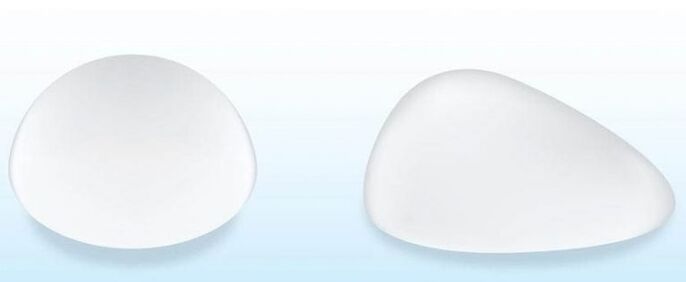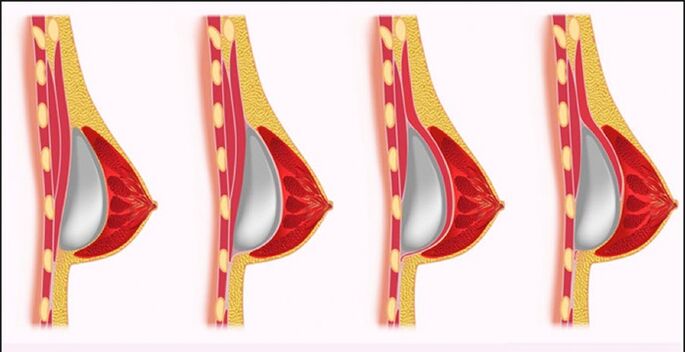Shape correction, breast augmentation is one of the most popular plastic surgery procedures. With the help of mammoplasty, you can correct congenital or acquired breast defects, restore its volume, elasticity after childbirth and lactation. Properly done surgery helps a woman become more attractive, more confident in herself.
Indications for surgery
- Heredity and decreased elasticity of the mammary glands (mastoptosis).
- Increased breast volume while maintaining its tone and position (macropathy).
- Decreased mammary glands after lactation.
- Small breast size (micromastia).
- Enlarged breast volume in men (gynecomastia).
Types of mammoplasty
- Augmented mammoplasty(endoprosthetics) - breast augmentation, correction of its shape using implants. It is used after childbirth, lactation, with congenital asymmetry.
- Reduction of mammoplasty- Decreased breast size with mastoptosis or macropathy.
- Mastopexy- Breast lift. This is indicated for mastoptosis, if the number of breasts qualifies for surgery.
Endoprosthetics of the mammary glands
This operation involves the installation of a silicone prosthesis (implant) into the mammary gland. The choice of incision site suits the woman. The implant is placed under the pectoral muscle, and if the amount of the breast allows, between the muscle and the mammary gland. Incisions are sewn, drainage is not required. Nipples and areolas enlarge after surgery.
Breast implants
Silicone or polyurethane endoprostheses correct the volume, shape of the breast, give a natural body tissue feel.
The lifespan of the implant exceeds 15 years, after which it is recommended to be replaced.

Products differ in several indicators:
- Fillers: gel or cohesive salt (sodium chloride). The gel composition is more elastic, homogeneous, lightweight, but harmful to the body if leaking. Salt solutions are safer, softer, cheaper. Negative traits - revenge when moving, prone to leaks.
- Structure: coarse (textured) or fine. Textured implants are more stable, but skin folds can appear as a result of friction of body tissue to its surface. The disadvantage of smooth dentures is the possibility of displacement.
- Shape: anatomical or round. The former has a more natural appearance, while the latter retains the symmetry and shape of the breast even when replaced.
Reduction of mammoplasty
During this type of surgery, adipose tissue and breast tissue are partially removed, their size is changed, and a new shape is given.
Excessive tissue intake reduces the chances of cancer.
Mammoplasty reduction options:
- Liposuction. This method is considered conservative and does not leave seams. Designed for small breast reduction with mild mastoptosis.
- Short stitching (vertical). A popular method in which the breast retains its natural shape and the nipples are sensitive. The operation takes little time, and the complication rate is low.
- T -shaped piece (anchor). Classical method, used to remove large amounts of tissue. The disadvantage is the recovery period, large scars.
- Amputation with nipple transplantation. It is used for very large breasts. This method is associated with a high risk of injury to the mammary glands, loss of nipple sensitivity, and inability to breastfeed.
Mastopexy
Breast removal without implants can be done in several ways:
- Vertically used for mastoptosis 1-2 degrees, seams are almost invisible, long-lasting cosmetic effect. The method is not effective for lowering the breast 3-4 degrees.
- Anastor mastopexy gives good results for ptosis of any complication. Disadvantages include a longer recovery period, significant suturing, increased risk of injury to breast tissue.
- Periareolar mastopexy is the removal of a small piece of skin around the areola. It is indicated for pseudoptosis, because other forms of breast sagging are ineffective.
Operation rating
For excellent plastic surgery results, high quality medical treatment at all 3 stages is essential. The preparation period lasts 1-2 weeks. The surgical intervention actually takes 1 to 4 hours.
Full recovery occurs within 1. 5 months.
Prepare for mammoplasty

The operation is performed no earlier than one year after the end of breastfeeding. 2 weeks before surgery, it is forbidden to take hormonal contraceptive pills, Aspirin and preparations containing salicylates.
You have to stop drinking alcohol, smoking.
In preparation, research must be done:
- general blood and biochemical tests;
- electrocardiogram;
- blood tests for anticoagulants (coagulogram);
- Ultrasound of the mammary glands;
- general urine analysis
- tests for hepatitis and HIV viruses.
Course of surgical intervention

Bust plasty is performed under general anesthesia. The typical type is the dermotency expander. It is used to increase breast volume with its own lack of tissue and large implant size. This procedure is carried out in 2 stages. First, an expander device is installed to stretch the breast tissue gradually over 1. 5-2 months.
When the desired size is reached, an endoprosthesis is placed on the breast.
Operating cutting method:
- Through the folds under the breast (submarial access). Safe method for mammoplasty enlargement. Scars from 4-5 cm long incisions disappear over time under slightly lowered breasts. Access is difficult to do with mycomastia in skinny girls.
- Incisions around or along the lower arch of the areola (periareolar approach). Advantages - surgical scars are almost invisible. For patients who plan to breastfeed, this method is not recommended because of the high risk of breast injury.
- Endoscopic enlargement through the axillary approach. High -tech equipment helps install implants without damaging blood vessels and nerve fibers. An incision length of 3-4 cm is made in the axillary zone, and then the scar is naturally masked. There is a limit on the number of implants - up to 400 ml.
- Endoscopic access through the navel. This method is little used because of the distance from the entrance to the operating location, the difficulty with the formation of a "pocket" for the prosthesis.
Recovery after mammoplasty

If the operation is performed without complications, the patient spends up to 3 days in the hospital. After going out, it is necessary to attend a bandage. Moderate pain in the intervention area that occurred in the first few days was considered natural. The feeling of tightness of the skin may be due to postoperative edema, which subsides after about 5-7 days.
After 4-6 weeks, the breast is slightly sagging, looks more natural, and a capsule forms around the implant.
Successful recovery rules:
- Do not load the shoulder belt, do not lift weights.
- Do not visit the fitness club, swimming pool, sauna, bath.
- Sleep on your back.
- Don't raise your hand.
- After breast augmentation, be sure to wear compression garments.
Possible complications
- Capsule contracture. The body forms a shell around the endoprosthesis, which can lead to its displacement, violation of the symmetry of the mammary gland, and its hardening.
- Infection. Infection occurs during surgery due to violation of the rules of asepsis or after non -compliance with standards of antiseptic care. The specific risk period is 1 week after surgery.
- Keloid, hypertrophic scar. They appear if the body is prone to its formation. Its formation looks like a dense ridge that rises above the surface of the skin and spoils the appearance of the breast.
- Accumulation of blood, serous fluid (hematoma, seroma) and, as a consequence, darkening of skin color. It occurs when blood vessels, lymphatic vessels are damaged during surgery or during the recovery period. Complications appear due to low blood clotting, sharp rise in blood pressure, improper endoprosthesis.
- Decreased or loss of sensitivity of the nipple, areola. Often occurs when large breasts are reduced with reduced mammoplasty due to nerve damage.
- The implant ruptured. It occurs because of the thin shell, which is often found on inexpensive prostheses. Salt fillers are easily absorbed by the body without posing a danger. Damage to the endoprosthesis with a cohesive gel is not always visible, but is dangerous if silicone gets into body tissues.
Breastfeeding after surgery

The safest operation is through an incision in the armpit (transaxillary) or under the breast (submammary).
About a year after surgery, breastfeeding is allowed.
Breastfeeding problems can occur in the following cases:
- The endoprosthesis is placed so as to compress the mammary gland, reducing the amount of milk it produces.
- Cuts along the areola are more likely to injure the nerve endings around the nipple.
- Reduction plastic, which is associated with a reduction in breast size, interferes with the milk ducts, restricting its function.
In what cases is breast plastic surgery contraindicated?
- Cardiovascular disease, varicose veins (thrombophlebitis, thrombosis).
- Severe forms of mastopathy.
- Oncology.
- Blood clotting disorders, diabetes mellitus.
- Infectious diseases (ARVI, influenza).
- Neurology, mental disorders.
- Pregnancy, breastfeeding.
- Age under 18 years old.
Advantages and disadvantages of mammoplasty

Advantages of plastic breast correction:
- Application of modern interventions.
- Correction of congenital malformations and acquired mammary glands.
- Long -lasting and noticeable aesthetic effect.
- Short term operation.
- Ability to choose the shape, material of endoprostheses at will.
- Preservation of the ability to breastfeed.
Possible weaknesses include:
- Skin marks from incisions - sutures, scars (unless special absorbent material is used).
- Threat of complications (infection, breast deformity, bleeding).
- The need to change endoprostheses every 10-15 years.
- The high cost of mammoplasty.
- The need for general anesthesia.
- Painful sensation in the first days after surgery.
- The need to always wear compression pants.
- Long recovery period (from several months to a year) with rejection of sports, physical activity, pregnancy, lactation.


























